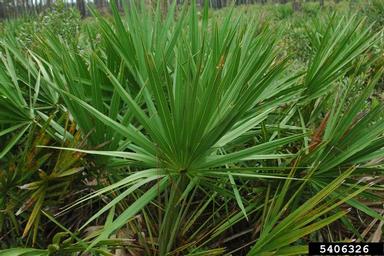
Nutrition
How does Saw Palmetto eat?
Serenoa repens is autotrophic. This means that it is
"self feeding." Like most plants, it does not eat animals
or other organisms. If you want to learn about a plant that does eat
animals, read about the
Venus Fly Trap or about
Sarracenia rubra. They are other really cool plants!

All plants have chloroplasts. Examples of some other interesting plants with chloroplasts are the Tea Plant and the Coast Douglas Fir. The chloroplasts are the site of a chemical process known as photosynthesis. A lot of the products made from this reaction are used in cellular respiration. The plant also uses some of the products for other chemical processes, such as making major organic molecules for the cells in the plant.
Picture Above: Karan A. Rawlins, University of Georgia, Bugwood.org
Photosynthesis
Saw palmetto uses light, water and carbon dioxide to make organic molecules. It goes through a process called photosynthesis. Photosynthesis is a process that converts light energy into carbohydrates.
The photosynthesis reaction looks like this:
Light + 6CO2 + H2O= Carbohydrates + 6 H2O + 6 O2
Like I have talked about on other pages, Serenoa repens has adapted to its environment in order to be efficient in collecting resources in a nutrient poor environments. One thing that the plant does specifically to conserve nutrients is recover nutrients from the leaves that are dying. It can conserve about 50% of a leaf's nitrogen and 33% of a leaf's phosphorous before the leaf is shed. This is important to the plant because it needs all the nutrients it can get in its poor environment. This is good recycling!
It is so cool how God has made these plants to be so efficient! Now check out how saw palmetto is used in Medicine. There is some controversy out there about it, so consult your doctor about any questions!
Want to go back to the main page? Click Home